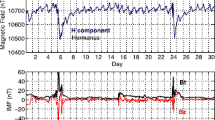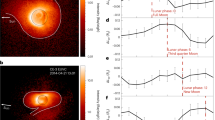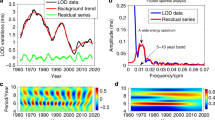Abstract
POLARISATION electric fields produced in the dynamo region should, theoretically, have a considerable effect on the distribution and energy of magnetospheric particles, but none has been found previously1–3. Here we show that the Dst index calculated by Sugiura and Poros4 shows a semidiurnal variation, which we attribute to the effect of tides (caused by the Moon) in the dynamo region, thus verifying the theory.
Similar content being viewed by others
References
Maeda, H., J. atmos. terr. Phys., 26, 1133–1138 (1964).
DeWitt, R. M., and Akasofu, S.-I., Planet. Space Sci., 13, 729–736 (1965).
Frank, L. A., Van Allen, J. A., and Craven, J. D., J. Geophys. Res., 69, 3155–3167 (1964).
Sugiura, M., and Poros, D. N., NASA Reports, X–645–71–278 (1971) and (1973).
Author information
Authors and Affiliations
Rights and permissions
About this article
Cite this article
KAMEI, T., MAEDA, H. Lunar effect in the quiet-time Dst index. Nature 259, 644–645 (1976). https://doi.org/10.1038/259644a0
Received:
Accepted:
Issue Date:
DOI: https://doi.org/10.1038/259644a0
- Springer Nature Limited





